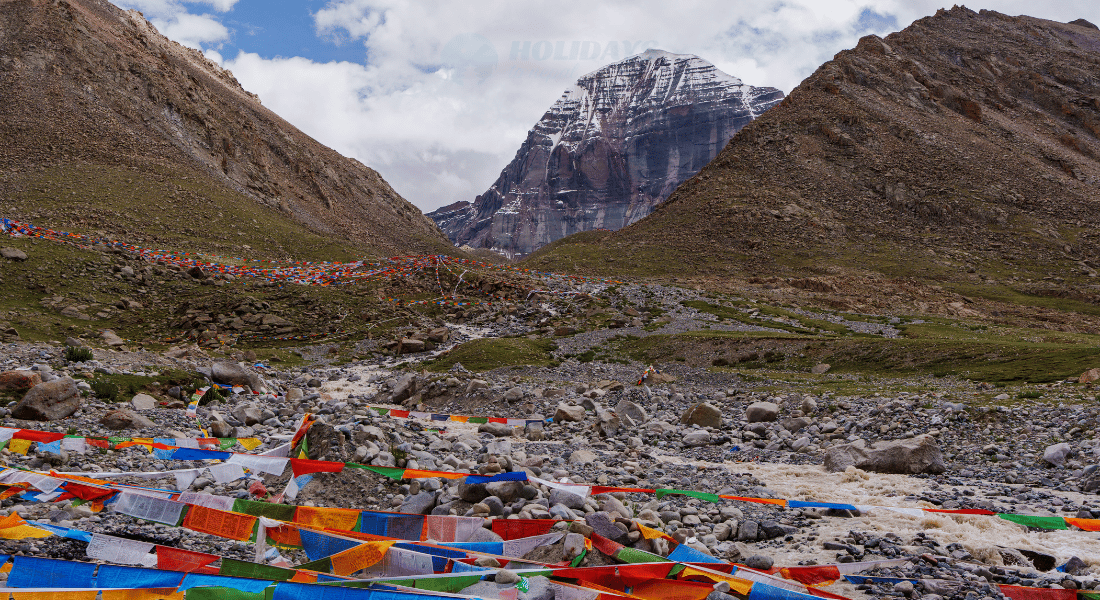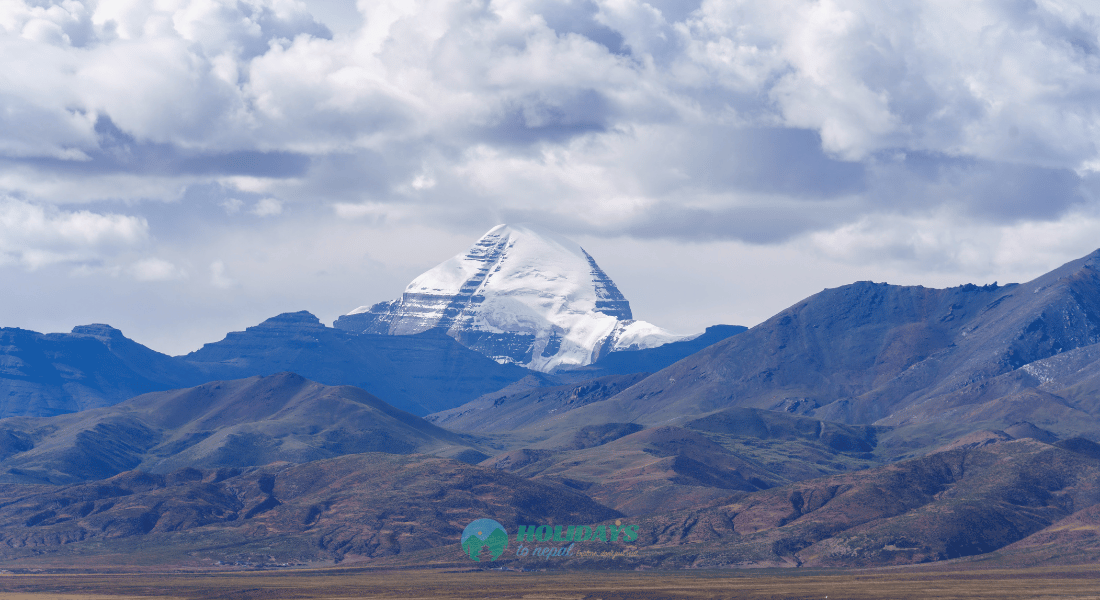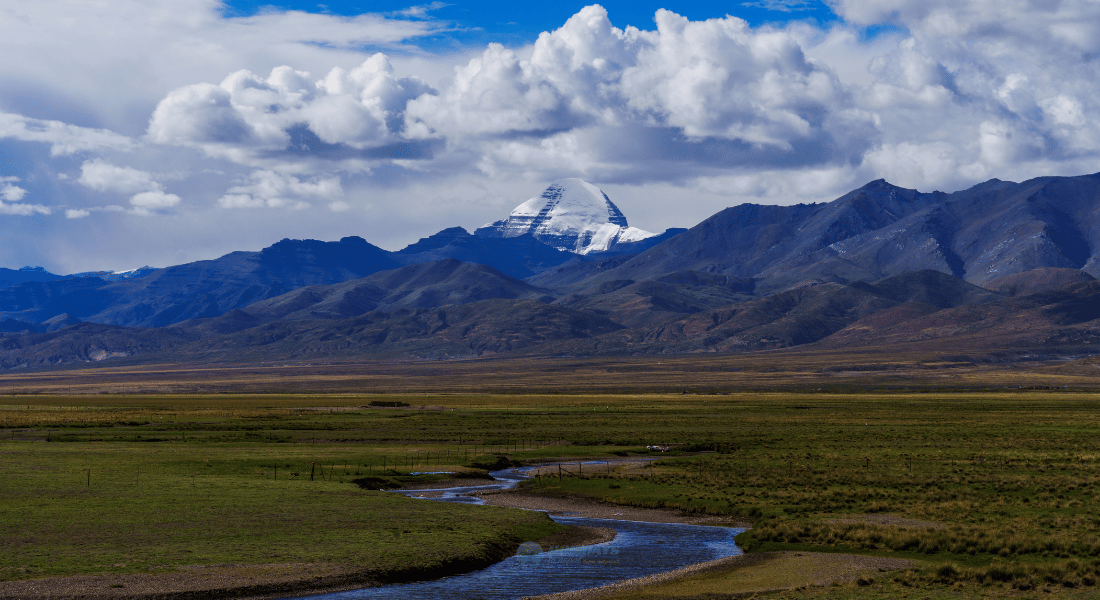Choosing a destination is easy, but deciding on the best time to go? It can be confusing. Considering the season is essential for optimising your Muktinath Temple visit. Discover your kind of season to visit Muktinath Temple at the Best Time to Visit Muktinath Temple. This article gives you insights on the seasonal variation of Muktinath Temple, guiding you to choose the ideal time for your journey in accordance with your desires.
Muktinath Temple, situated at an altitude of 3710m, is considered one of the world's highest temples. It is a sacred shrine holding significance for both Hindus and Buddhists, attracting pilgrims all over the world. Hindus consider it one of the 108 Divya Desams, divine abodes of Vishnu, and Buddhists honour it as Chumig Gyatsa, a mystical land of 108 water sprouts. However, Muktinath isn’t just a pilgrimage; it is a journey through the valley, traditional villages, thin Himalayan air, and varied climates, challenging you both physically and mentally, no matter what transport you choose. The beauty of Muktinath blooms differently, with each season revealing its own unique charm.
|
Muktinath Tour Packages |
Starting Costs (3 Star Hotels) |
|
INR 29,000 Per Person (Get a Quote) |
|
|
INR 40,000 Per Person (Get a Quote) |
|
|
INR 42,000 Per Person (Get a Quote) |
|
|
INR 45,500 Per Person (Get a Quote) |
|
|
INR 49,000 Per Person (Get a Quote) |
|
|
INR 55,000 Per Person (Get a Quote) |
|
|
INR 98,000 Per Person (Get a Quote) |
|
|
INR 1,91,000 Per Person (Get a Quote) |
Choosing the ideal time mainly emphasises the season with excellent climatic conditions and breathtaking landscape views for the best experience. In fact, the perfect season isn’t just about temperature and weather; it dictates the crowds you’ll encounter, the activities you can enjoy, and even the cultural events/festivals you might witness. Hence, regarding Muktinath, of course, the perfect time to visit depends not just on the weather but on your personal preferences as well. Are you a seasoned traveller or a first time adventurer looking for luxury travel? Do you prefer vibrant festivals or prefer less crowded times? Reflecting on your own needs will help you choose the season that connects the most with your soul. So, this blog assists you in choosing the best time that aligns with your desired weather, scenic preference, crowd, and personal comfort to ensure a truly memorable and fulfilling pilgrimage.
Also Read: Muktinath Tour Package From India
Table Of Content
- Muktinath Temple Significance
- Geographical and Climatic Overview
- Ideal Season to Visit
- Major Festivals and Cultural Events
- Practical Travel Tips for Each Seasons
- Navigating the Trek and Altitude
- Altitude Sickness Prevention Tips
- Muktinath Tour Attractions
- Responsible Trekking and Sustainable Practices
- Conclusion
Muktinath Temple Significance
Muktinath Temple, located in the Mustang district of Nepal, is a blend of spirituality, breathtaking landscapes, cultural richness, and challenges that come with the altitude and seasonal variation. Muktinath Temple serves as a significant Hindu and Buddhist pilgrim’s site for liberation and spiritual guidance. Hindus consider it one of the 8 most sacred shrines, the “Swayam Vyakta Kshetras," where Lord Vishnu manifested himself. Muktinath in Hindi translates to the place of liberation, where bathing in the 108 water sprouts and taking a holy dip in the ponds is believed to wash away the sins and help to achieve liberation from the cycle of birth and death. Similarly, for Buddhists, they call the place Chumig Gyatsa, meaning hundred waters, referring to the 108 water sprouts. Muktinath is one of the 24 Tantric places, considered by Vajrayana Buddhists to hold powerful spiritual energy.

Besides the religious and spiritual significance, the journey to Muktinath Temple takes you through the natural settings of the Mustang district. It stands at an altitude of 3710m above sea level, amidst the stunning Annapurna and Dhaulagiri ranges, offering a divine spiritual experience. The harsh yet magnificent terrain transforms its beauty differently with each season. All in all, the combination of the temple’s holiness and natural beauty creates a memorable journey.
Geographical and Climatic Overview
Muktinath Temple is a spiritual shrine amidst the lap of the Himalayas, such as Annapurna I and Dhaulagiri. Its high altitude location at 3710m serves as a unique blend of magnificent geography and dynamic climate that shapes both the challenge and uniqueness of the whole journey. Mustang can be broadly divided into two regions: Upper and Lower Mustang. Lower Mustang has gentler slopes and a fertile valley, while Upper Mustang, in comparison, is a high- altitude desert. This region as a whole is a combination of extremes, towering peaks, and deserted valleys, stretching north onto the Tibetan Plateau. With the Kali Gandaki river finding its way through the heart of Mustang to its gorge, which is the deepest gorge in the world, this region caters to the most diverse and unique terrain.

Mustang sits in the thin air zone, receiving a little rainfall throughout the year, making it a deserted rain shadow area. This region is characterised by year-round dryness and cool temperatures. The average temperature is around 16°C, with significant variations depending on the season and altitude. Muktinath, located in the lower Mustang region, experiences variances in weather patterns according to climatic conditions and 4 different seasons.
Ideal Season to Visit
Muktinath welcomes travellers year-round as it offers a diverse season, each with its own unique beauty. However, the journey to Muktinath is not just about choosing the particular dates to travel; it's about your preferences for the different seasons and environments you want to travel in, meeting your expectations, and challenging your own comfort zone. Here’s a detailed list of the seasons ideal for your journey to Muktinath.

Spring Season (March to May)
This season, from March to May, is considered one of the best seasons to travel to Muktinath. During this time, the valleys are covered in beautiful rhododendrons and create a colourful background against the stunning snow-capped mountains. It offers a delightful rest from the crowdy peak seasons, allowing you to soak up the region’s beauty in quieter surroundings. With an average temperature of around 12°C, this time period welcomes one with gentle warmth and a pleasant temperature. However, you might still experience chilly nights. Make sure to pack layers of clothing to adjust to changing temperatures and unpredictable weather patterns, especially snowfall.
Summer/Monsoon Season (June to August)
The season from June to August in Muktinath is considered the warmest, with temperatures reaching up to 23°C. You will find lush green landscapes against towering mountains during this season. Whether you trek or drive, it can be challenging due to unpredictable weather patterns and limited flight options. Also, landslides could affect your travel plans. However, adventurous souls who enjoy challenging treks will be able to see the beauty of vibrant wildflowers over the valley, with occasional monsoon showers. The availability of fewer crowds in comparison to peak season makes your travel even more engaging. You must prepare well to travel in this season, which includes proper packing of gear such as a windcheater, raincoats, and sturdy hiking boots.
Autumn Season (September to November)
Considered the best season to travel, autumn welcomes the traveller to Muktinath with clear skies, gentle air, and pleasant weather with an average temperature of 15°C.
The perfect harmony of beautiful scenery and pleasant weather creates the perfect setting for outdoor explorations. September–November is the peak season, which welcomes a lot of crowds on the pilgrimage journey. Also, this is a festive time for Nepali people for celebrations of major festivals like Dashain and Tihar, which caters to your experience of these vibrant festivals in Nepal. The breathtaking backdrops of natural beauty and spirituality surrounding the temple let you get the most out of your holy pilgrimage. Moreover, you might experience slight rainfall in early September. So, don’t forget to pack items such as raincoats and windcheaters.
Winter Season (December to February)
December to February is the coldest season, with temperatures below freezing (average temperatures -1°C). The travel routes in higher areas are mostly covered with snow, which makes trekking and other outdoor activities difficult. This season is less favourable for a pilgrimage journey to Muktinath, but those adventurous souls seeking challenges and those who can brave the season will be rewarded with a unique spirituality. Also, due to the minimal crowd, it offers you a sense of solitude and an undisturbed travel experience. However, it demands careful planning, proper gear such as thermal layers, sturdy hiking boots, crampons to access through the snow, a down jacket, and warm trousers.
Also Read: How to Reach Muktinath Temple
Major Festivals and Cultural Events
Muktinath, nestled high in the Himalayas, isn’t just a pilgrimage site but also a journey unfolding different festivals and cultural events. Scheduling to align with these festivals will be a great way to immerse yourself in these vibrant festivals of the region, giving you cultural insight alongside spiritual blessings. Festivals celebrated here display ancient stories and myths, bring history to life, and provide a deeper understanding of the region's cultural heritage. Here are some festivals celebrated in Muktinath:
Yartung Festival

Yartung is the major festival celebrated in the Lower Mustang. Yartung, marking “end of summer” in the local language, is a festival celebrated during August full moon day every year. It is celebrated in the Mustang region of Nepal and lasts for about three days. In this festival, the local kings, lamas, and villagers each take turns celebrating. The major highlight of the festival is the horse race, where skilled horse riders from nearby villages compete across the vast plains. The locals proudly showcase their traditional attire, where men display their tunics and sashes while women steal the show with their jewellery and silk gowns. In fact, travelling during this festive season is an opportunity to connect with the rich culture and traditions of the Mustang region.
Besides the Yartung festival, Muktinath temple hosts other Hindu cultural events such as Haribodhini Ekadashi and Harishayani Ekadashi. Harishyani Ekadashi is a fast observed on the eleventh lunar day, falling in mid-June. It marks the day Lord Vishnu retires for four months for his night hours, also known as cosmic slumber. Similarly, Haribodhini Ekadashi is a festival that marks the awakening of Lord Vishnu from his fourth month of night hours and begins his activities of creation and preservation. On these days, Hindu devotees believe that the power of Lord Vishnu is really strong and visit Muktinath to receive the blessings.
Practical Travel Tips for Each Seasons
The pilgrimage journey to Muktinath Temple offers weather conditions that vary significantly across different seasons, affecting your overall plans and preparations. Since the temple is located remotely at a high altitude with challenging terrain, it is important to plan well for a safe, enjoyable, and respectable experience. A well-planned trip is not just about ensuring your own safety but also respecting the unique culture and fragile environment.
Travel Advices
In winter (December–February), the region experiences its coldest temperatures around -1°C, with chilly nights and occasional snowfall. It's a necessity to pack heavy winter clothing, thermal layers, and proper trekking gear, such as trekking boots that can access snow or crampons to navigate the snow.
Spring (March–May) embraces one in a gentle warmth, with the rise in temperature reaching around 12°C. Carry light layers of clothes for fluctuating temperatures. Also, be prepared for occasional dust and storms.
As the seasons change to summer (June–August), the temperature rises to 23°C, making it the warmest time of the year. Risk of landslides, muddy roads, and slippery slopes. It would be helpful if you carried raincoats for sudden rainfall, a windcheater to avoid harsh wind, and sturdy boots to access slippery trails. Make sure to check the road conditions before departing.
Lastly, the season of autumn (September–November), with slight rainfall in early September, is considered the best climate, with an average temperature of 15°C, making it the most ideal time to visit the region. Carry warm layers for chilly mornings and evenings.
Accommodation Options
Choosing the right accommodation when travelling depends on your budget, travel style, and level of comfort. More than that, while travelling to Muktinath, accommodation options adapt to the seasonal variations, which directly impact your schedule and itinerary. The Mustang region offers a range of accommodation options, such as guesthouses, lodges, homestays, and a few luxury resorts and hotels. Its price and availability fluctuate throughout the year. Mentioned below are some ways you can get insights on the local accommodations and make proper reservations for them.
Homestays
With the warmth of Tibetan hospitality, homestays in Muktinath offer basic comforts like shared bathrooms and home-cooked meals, making them a budget-friendly option.
Guesthouses
Guesthouses in Muktinath provide private rooms with shared bathrooms and hot water, perfect for solo travellers or groups seeking affordability and comfort.
Lodges
Lodges in Muktinath differ from basic to mid-level with private rooms, hot water, basic meals, as well as an attached bathroom in some. With comfortable beds and clean facilities, some lodges even have dining areas and courtyards. Choose lodges offering proper insulation and heating systems if you’re travelling in the winter season.
Resorts
Muktinath offers only a few high-end resorts with luxurious stays. It provides amenities such as fine dining areas and spa treatments.
Monasteries
Some monasteries in Muktinath provide shelter with basic accommodations and offer unique spiritual experiences. Some monasteries might open, but some might close during the winter season.
It is necessary that you book your desired accommodation well in advance, especially during the autumn season (September–November), which is a peak season. Also, affordable accommodations such as homestays and guest houses tend to fill quickly in peak season. Moreover, consider your budget, desired level of comfort, and proximity to the temple when making your choice. If you want assistance in booking and making a reservation, we will be more than happy to be part of your journey.
Navigating the Trek and Altitude
High in the Himalayas of Annapurna, Muktinath temple calls for pilgrims and adventurers worldwide. The challenging yet rewarding trek travels through rugged trails, ancient villages, and breathtaking landscapes, testing your limits while connecting your soul with the high altitude. As you trek higher, the risk of altitude sickness and the need for acclimatisation become more apparent. Your guide will be there to assist you, but it's best that you’re always well prepared for any challenges on the trail.
Trekking Routes to Muktinath Temple
Your trekking trails might differ depending on the routes you want to take. The sacred site of Muktinath offers you various routes, each revealing its own beauty and unique experiences. Whether you seek to trek through classic Jomsom Muktinath, take a round trip through the Annapurna massif, or explore the remote Upper Mustang, Muktinath connects with you from everywhere. Here are some trekking routes you can take to Muktinath Temple:
Jomsom Muktinath Trek

It is a classic, moderate route, perfect for beginners. You can choose either a flight or drive to Jomsom and start your trek from Jomsom via Kagbeni to Muktinath. To take a flight to Jomsom, you must reach Pokhara and take a flight from there, as direct flights from Kathmandu to Jomsom aren't available.
Annapurna Circuit Trek
It is a longer and more challenging trek (around 10–12 days) in comparison around the Annapurna massif, through different landscapes. It takes you to the highest point of the trek, Thorong La Pass (5416 metres above sea level). There are higher chances of getting altitude sickness on this route, so good preparation for both physical and mental fitness is essential. You will start your trek from Dharapani, trek to Muktinath, and then back through a round route from Jomsom, Pokhara, and Kathmandu.
Learn More: Annapurna Circuit Trek
Upper Mustang Trek

It is a trek through the restricted region of Nepal, exploring the deserted land and barren landscape, which reveals the hidden world of the ancient Buddhist Kingdom of Mustang. You can either fly or drive to Jomsom and start your trek to Muktinath, trek to the highest point, Lo Manthang (3840 m), and then back through the same route.
Learn More: Upper Mustang Trek
Altitude Sickness Prevention Tips
Muktinath temple, located at an elevation of 3710 metres, offers breathtaking scenery amidst the lap of the Himalayas. With its stunning view, the high altitude presents a significant risk of altitude sickness, which demands both mental and physical preparation. Mentioned below are some tips to deal with altitude sickness and have a seamless pilgrimage journey.
Acclimatization
It is necessary to take a gradual ascent and let your body adjust to the thin mountain air. Walking at the same pace will prevent altitude sickness and carry oxygen efficiently.
Hydrate Regularly
Hydrating your body regularly is essential, even on normal days. While you are trekking, sip water regularly, even if you don’t feel thirsty. Dehydration worsens altitude sickness. You can also choose to drink herbal remedies such as ginger tea or ginger water.
Communicate with your body
You should always listen to your body. Listening and communicating the symptoms of altitude sickness means its early prevention. Symptoms such as headaches, nausea, loss of appetite, and difficulty sleeping call for immediate care and descent. Establish a regular sleep schedule, avoid caffeine, avoid heavy meals, and choose anti-vomiting or pain relief medications to reduce the symptoms.
Medical Backup
Before starting your trip, prepare a medical kit with the necessary first aid for the trek. An altitude-prevention medication such as diamox can be taken. In addition to that, if you have medicine you’re taking regularly, don’t forget to carry it or its prescription.
Descent Immediately
Prioritising your health is over everything. Don’t ignore the severe symptoms, such as dizziness and difficulty breathing, that necessitate an immediate descent to a lower altitude. You must consult your guide or ask for medical attention if necessary.
Overall, one must always remember that Muktinath is not just about a visit to the sacred temple; it is a journey that involves accessing all the challenges throughout the journey. Prioritise your well-being, navigate the challenges, and embrace the beauty of the Himalayas as you make your way towards this holy site.
Muktinath Tour Attractions
In addition to being a popular attraction itself, Muktinath Temple is a significant location that satisfies a variety of travel needs with its proximity to other stunning natural, culturally diverse, and spiritual sites. Some amazing attractions you might find on the way to Muktinath are:
By Air
You can take a flight to Jomsom from Pokhara. From Jomsom to Muktinath, mentioned below are the attractions around the area.
Muktinath Temple

Muktinath is the ultimate destination of your trip. It is a pagoda-style Hindu and Buddhist pilgrimage site. One of the highest altitude temples at an elevation of 3710m, it caters to the pleasant Himalayan air, Himalayan landscapes, and the spirituality that comes within. It features 108 water sprouts and two small ponds, which are believed to liberate you from the cycle of birth and death. Hindus consider it one of the 108 Divya Desams, and Buddhists regard it as one of the 24 Tantric places, considered by Vajrayana Buddhists to hold powerful spiritual energy. The other small sites surrounding it are Jwala Mai Temple, a tibetan-style architecture resembling a tibetan gompa, and Sakyamuni Buddhist Statue, depicting Sakyamuni Buddha in Bhumisparsha Mudra.
Learn More: Muktinath Temple
Dhumba Lake

Dhumba Lake is situated at an altitude of 2380 metres, which is 5–6 km from Jomsom. It is often referred to as a heart-shaped lake due to its distinctive form. It is believed to have mystical origins and claims that the water possesses the power to cleanse sins and grant wishes. Taking a walk from Jomsom to the lake is a great way to immerse yourself in local culture and stunning scenery.
Kagbeni

Kagbeni is one of the oldest villages in the Himalayas and is a gateway to the restricted region of Upper Mustang. It has served as a salt trade route between Nepal and Tibet for centuries. Moreover, the Kagbeni Gompa, an ancient Buddhist monastery in Kagbeni, represents the long-running history of the region. Besides that, it holds religious significance for Hindus as it's a holy site for performing Pitri-Puja, a ritual freeing ancestral souls.
By Drive
Along with the attractions mentioned above, here are some other attractions you will be able to enjoy on your way, which is only possible if you travel by road.
Rupse Waterfall

Rupse Waterfall is one of the tallest waterfalls in Nepal, with a height of 300 metres. It is along the Beni-Jomsom Highway route, at a distance of about 110 km from Pokhara. There are waterfalls and lush green forests all around the waterfall, which enhances its scenic appeal.
Kaligandaki River
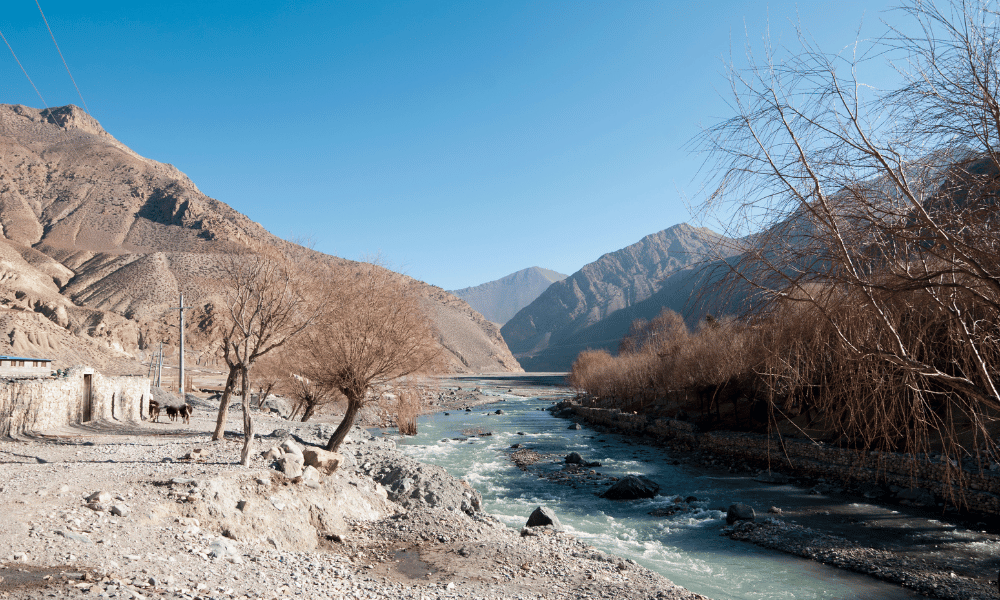
The Kaligandaki river flows through the Mustang region of Nepal, which is a major source of water for this region. Kali Gandaki River Gorge, which claims itself as the deepest gorge in the world, making its way through the heart of the Himalayas, is also one of the attractions on your way to the pilgrimage. Moreover, it is famous for saligram (fossils), which hold great significance for Hindus. Hindus consider these fossils to be manifestations of Lord Vishnu, making them highly available for worship and spiritual practice.
Marpha Village
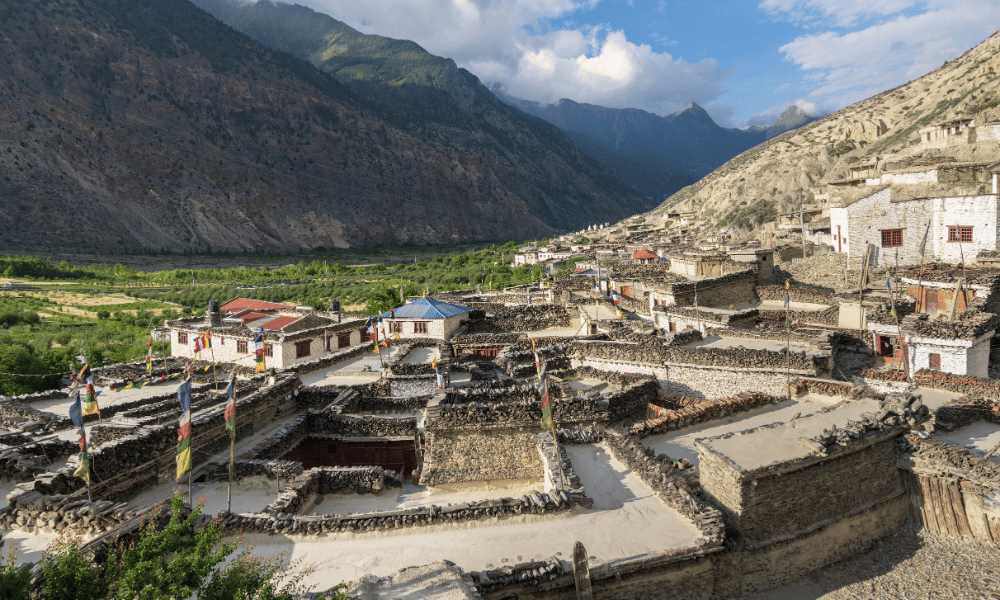
Marpha is a picturesque village, situated at 2650 metres. Marpha sits amidst the drastic scenery of Kali Gandaki Valley. It is famous for its traditional settlement and apple production. The village offers the exploration of quaint, mudbrick houses with traditional flat roofs and prayer flags.
Responsible Trekking and Sustainable Practices
Trekking to Muktinath Temple offers you an unforgettable experience, breathtaking landscape views, cultural encounters, and spiritual connection. . However, it’s essential to be a responsible trekker and prioritise sustainable practices to preserve this sacred site and its surrounding environment. Its delicate mountain ecosystem, traditional villages, and cultural sites make it even more necessary to preserve it. Hence, it is recommended to make your journey both rewarding and mindful. Here’s how you can adopt those practices:

Minimise Waste
Pack reusable personal water bottles, containers, and bags to avoid unnecessary plastic waste. For instance, carry a towel instead of tissue paper to minimise waste. Consider using biodegradable products for personal hygiene items, such as biodegradable soaps and shampoos.
Reduce Water Wastage
As you will be travelling to a rain shadow area, the water resources are less in comparison to other areas. It is necessary that you are mindful of using the water resources properly. For instance, avoid washing unnecessary clothes, take shorter showers, or adjust the water flow while taking a shower to avoid unnecessary use.
Hire a Responsible Guide
Choosing a local guide who is knowledgeable about local culture, sustainable practices, and the region helps you create a respectful experience. They assist you in navigating the trails, avoiding sensitive areas, and being mindful of local customs and traditions.
Dispose of Waste Properly
It is requested that you not litter the trails to comply with the rules and regulations of the region and manage your waste properly, either in your bags or designated dustbins.
Respect Local Culture
Mustang holds a deep cultural significance for the Mustang community. Also, you are travelling to rural areas, so avoid wearing revealing clothes, especially when visiting religious sites. It is suggested to be mindful of cultural sensitiveness and dress modestly.
Stick to Designated Trails
Avoid using off-beaten paths or creating shortcuts to prevent erosion and disturbance to the wildlife or vegetation of the area.
No matter what and which season you choose to travel, preparing well in each season lets you experience its unique charm as you navigate the high’s and low’s of the varying climatic conditions. Along with that, following the small steps of sustainable practices ensures a responsible and rewarding journey to Muktinath temple. Your careful preparations and mindful actions will contribute to preserving the delicate ecosystem, respecting the local culture, and ensuring a sustainable future for these sacred sites, their communities, and yourself as well.
Conclusion
As you stand before the majestic Muktinath temple, the beautiful atmosphere and spiritual vibe will make you reflect on the journey that led you there. Either you have taken a drive or a flight or will trek as well, the amazing views and surroundings served by the four different seasons: autumn, spring, summer, and winter will not disappoint you. By considering factors such as weather, crowd level, and personal comforts, you can adjust your schedule to prepare for this trip.
The Best Time to Visit Muktinath Temple explores the versatility of travelling in different seasons to Muktinath Temple, a high-altitude destination. This article serves as a guiding light for you in emphasising the significance of choosing the season best suited. This trip is all about you and the freedom of your choices. Ultimately, leading to a journey with a natural, cultural, and spiritual combination, this article invites you to reflect on your desires and travel styles, ensuring a well-prepared and memorable pilgrimage to the sacred Muktinath temple.



